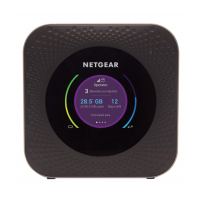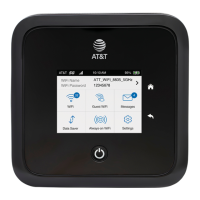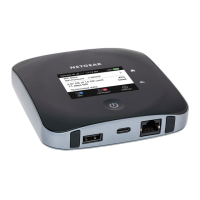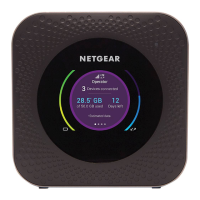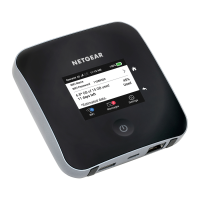Do you have a question about the NETGEAR MR70 and is the answer not in the manual?
Provides an overview of the router's physical components and status indicator lights.
Details the physical components and status indicator lights of the satellite unit.
Explains the information found on the router and satellite device labels, such as SSID and password.
Guides users on how to physically connect and power on the main router unit.
Instructs on optimal satellite placement and the process of synchronizing it with the router.
Explains how to establish a wired or wireless connection to the router network.
Details how to log in to the router's web interface for configuration and management.
Guides on installing and using the Nighthawk app to manage the mesh system.
Describes using the wizard to automatically detect and set up internet connection settings.
Provides steps for manually configuring internet connection details like login and IP settings.
Details how to configure IPv6 internet connection types for the router.
Explains how to adjust the Maximum Transmission Unit (MTU) size for network performance.
Guides on activating and managing NETGEAR Armor cybersecurity features using the mobile app.
Explains how to use MAC addresses to block or allow specific devices from network access.
Details how to block specific websites by entering keywords or domain names.
Guides on blocking specific internet services or applications based on type or schedule.
Allows scheduling when specific websites or services are blocked for network access.
Configures the router to send email alerts for security events like blocked site access.
Explains how to enable and configure Dynamic Quality of Service for better traffic prioritization.
Describes enabling UPnP to improve device discovery and connection on the network.
Guides on changing the WiFi network name (SSID) and security settings like WPA3.
Explains how to add additional 2.4 GHz or 5 GHz WiFi networks to the system.
Details how to set up a separate WiFi network for guests, with or without a password.
Describes using the WPS wizard for easy connection of WPS-enabled WiFi devices.
Explains how to enable or disable 20/40 MHz coexistence for the 2.4 GHz radio for speed or compatibility.
Guides on hiding the WiFi network name (SSID) from being broadcasted for increased privacy.
Details enabling or disabling fast roaming for smoother WiFi client transitions between mesh devices.
Provides instructions on changing the WiFi channel to reduce interference and improve signal.
Allows viewing and configuring Wide Area Network (WAN) settings like MTU size and firewall options.
Explains how to set up a default DMZ server for specific applications, increasing security risk.
Guides on changing the device name that appears on the network file manager.
Details how to change the router's Local Area Network (LAN) IP address and subnet mask.
Explains how to define the range of IP addresses the router assigns via DHCP to connected devices.
Allows assigning static IP addresses to specific devices on the LAN for consistent network access.
Guides on manually setting the router's time zone and daylight saving time adjustments.
Instructions on configuring the router to function as a Wireless Access Point (AP).
Explains setting up bridges for port groups or VLAN tags, often for IPTV services.
Details how to manually configure static routes for specific network traffic paths.
Guides on checking for and installing new firmware updates for the router and satellites.
Provides steps for manually uploading firmware files to the router and satellite devices.
Allows configuring automatic or manual updates for future firmware versions.
Covers changing the admin password, enabling reset, and the reset process itself.
Guides on enforcing HTTPS connections for secure access to the router's web interface.
Shows how to view router status, internet port, WiFi settings, and connection details.
Explains how to view logs, attached devices, traffic statistics, and satellite status.
Guides on setting up Dynamic DNS and using Anywhere Access for remote network management.
Covers backing up, restoring, or erasing router configuration settings for recovery.
Details how to reset the router or satellite to their original factory default settings.
Provides an overview of Virtual Private Network (VPN) connections and client-to-gateway tunnels.
Guides on enabling the OpenVPN service on the router to allow VPN connections.
Explains how to install OpenVPN client software and configuration files on various devices.
Details how to use the VPN connection to access your home internet service while away.
Describes how to block VPN clients from accessing the internet, restricting them to the home network.
Guides on configuring port forwarding rules to allow specific incoming traffic to reach local servers.
Explains how to add custom port forwarding rules for services not listed by default.
Details how to set up port triggering to dynamically open ports based on outbound traffic.
Guides on enabling the port triggering feature for dynamic port management.
Provides essential steps for safely restarting your network equipment in sequence.
Offers steps to diagnose and resolve problems with connecting to the mesh WiFi network.
Helps resolve issues where the router has an IP but web pages cannot be loaded.
Provides guidance for troubleshooting PPPoE internet connection problems.
Explains how to use the ping utility to test network path connectivity to devices.
Lists the default factory settings for the NETGEAR Nighthawk MR70 router.
Lists the default factory settings for the NETGEAR Nighthawk MS70 satellite.
Details the technical specifications, including data rates, protocols, and hardware for the router.
Details the technical specifications for the satellite, including data rates and hardware.
Provides an overview of the router's physical components and status indicator lights.
Details the physical components and status indicator lights of the satellite unit.
Explains the information found on the router and satellite device labels, such as SSID and password.
Guides users on how to physically connect and power on the main router unit.
Instructs on optimal satellite placement and the process of synchronizing it with the router.
Explains how to establish a wired or wireless connection to the router network.
Details how to log in to the router's web interface for configuration and management.
Guides on installing and using the Nighthawk app to manage the mesh system.
Describes using the wizard to automatically detect and set up internet connection settings.
Provides steps for manually configuring internet connection details like login and IP settings.
Details how to configure IPv6 internet connection types for the router.
Explains how to adjust the Maximum Transmission Unit (MTU) size for network performance.
Guides on activating and managing NETGEAR Armor cybersecurity features using the mobile app.
Explains how to use MAC addresses to block or allow specific devices from network access.
Details how to block specific websites by entering keywords or domain names.
Guides on blocking specific internet services or applications based on type or schedule.
Allows scheduling when specific websites or services are blocked for network access.
Configures the router to send email alerts for security events like blocked site access.
Explains how to enable and configure Dynamic Quality of Service for better traffic prioritization.
Describes enabling UPnP to improve device discovery and connection on the network.
Guides on changing the WiFi network name (SSID) and security settings like WPA3.
Explains how to add additional 2.4 GHz or 5 GHz WiFi networks to the system.
Details how to set up a separate WiFi network for guests, with or without a password.
Describes using the WPS wizard for easy connection of WPS-enabled WiFi devices.
Explains how to enable or disable 20/40 MHz coexistence for the 2.4 GHz radio for speed or compatibility.
Guides on hiding the WiFi network name (SSID) from being broadcasted for increased privacy.
Details enabling or disabling fast roaming for smoother WiFi client transitions between mesh devices.
Provides instructions on changing the WiFi channel to reduce interference and improve signal.
Allows viewing and configuring Wide Area Network (WAN) settings like MTU size and firewall options.
Explains how to set up a default DMZ server for specific applications, increasing security risk.
Guides on changing the device name that appears on the network file manager.
Details how to change the router's Local Area Network (LAN) IP address and subnet mask.
Explains how to define the range of IP addresses the router assigns via DHCP to connected devices.
Allows assigning static IP addresses to specific devices on the LAN for consistent network access.
Guides on manually setting the router's time zone and daylight saving time adjustments.
Instructions on configuring the router to function as a Wireless Access Point (AP).
Explains setting up bridges for port groups or VLAN tags, often for IPTV services.
Details how to manually configure static routes for specific network traffic paths.
Guides on checking for and installing new firmware updates for the router and satellites.
Provides steps for manually uploading firmware files to the router and satellite devices.
Allows configuring automatic or manual updates for future firmware versions.
Covers changing the admin password, enabling reset, and the reset process itself.
Guides on enforcing HTTPS connections for secure access to the router's web interface.
Shows how to view router status, internet port, WiFi settings, and connection details.
Explains how to view logs, attached devices, traffic statistics, and satellite status.
Guides on setting up Dynamic DNS and using Anywhere Access for remote network management.
Covers backing up, restoring, or erasing router configuration settings for recovery.
Details how to reset the router or satellite to their original factory default settings.
Provides an overview of Virtual Private Network (VPN) connections and client-to-gateway tunnels.
Guides on enabling the OpenVPN service on the router to allow VPN connections.
Explains how to install OpenVPN client software and configuration files on various devices.
Details how to use the VPN connection to access your home internet service while away.
Describes how to block VPN clients from accessing the internet, restricting them to the home network.
Guides on configuring port forwarding rules to allow specific incoming traffic to reach local servers.
Explains how to add custom port forwarding rules for services not listed by default.
Details how to set up port triggering to dynamically open ports based on outbound traffic.
Guides on enabling the port triggering feature for dynamic port management.
Provides essential steps for safely restarting your network equipment in sequence.
Offers steps to diagnose and resolve problems with connecting to the mesh WiFi network.
Helps resolve issues where the router has an IP but web pages cannot be loaded.
Provides guidance for troubleshooting PPPoE internet connection problems.
Explains how to use the ping utility to test network path connectivity to devices.
Lists the default factory settings for the NETGEAR Nighthawk MR70 router.
Lists the default factory settings for the NETGEAR Nighthawk MS70 satellite.
Details the technical specifications, including data rates, protocols, and hardware for the router.
Details the technical specifications for the satellite, including data rates and hardware.
| Brand | NETGEAR |
|---|---|
| Model | MR70 |
| Category | Wireless Router |
| Language | English |



